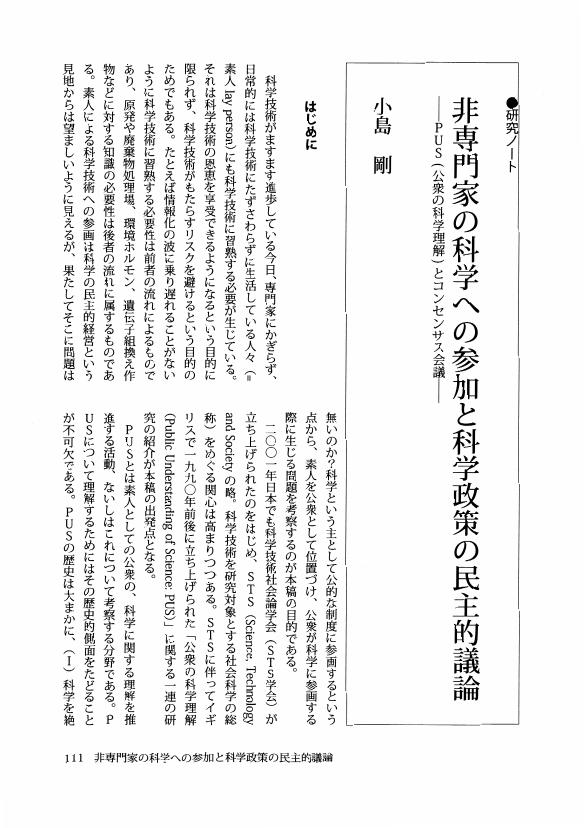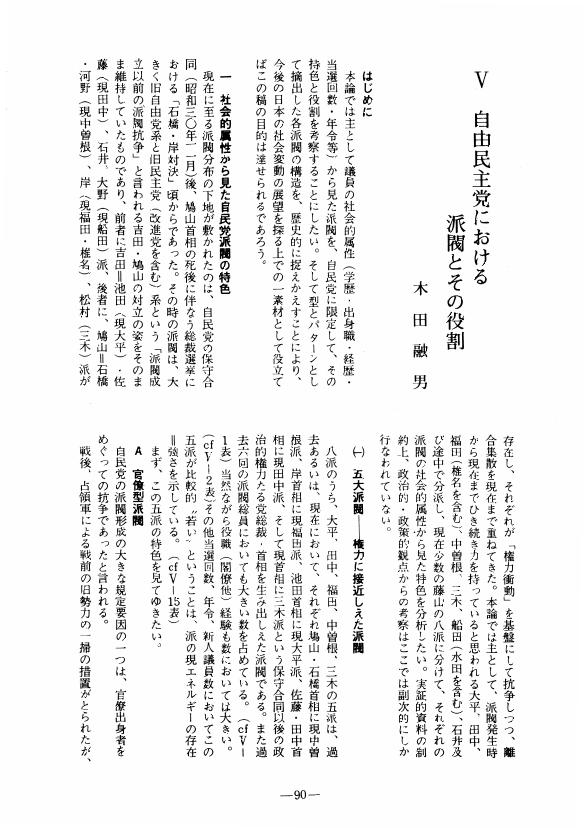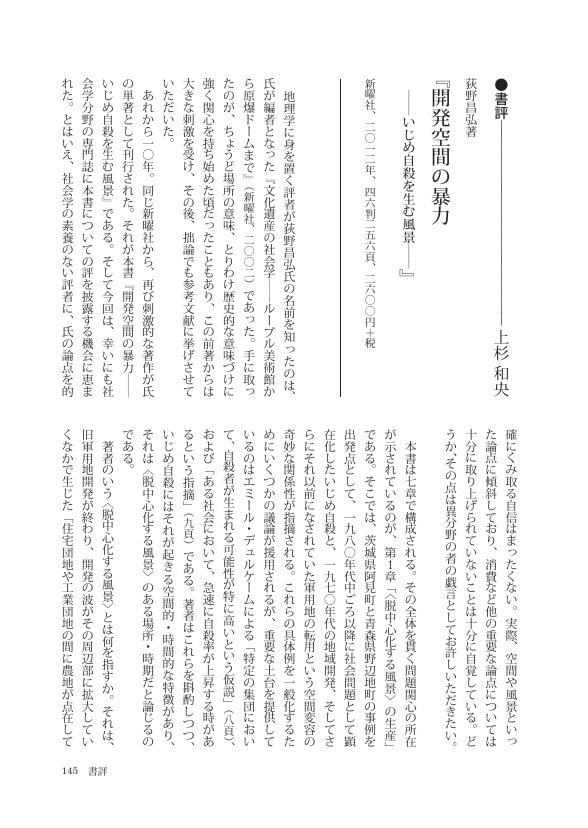1 0 0 0 OA 非専門家の科学への参加と科学政策の民主的議論 PUS(公衆の科学理解)とコンセンサス会議
- 著者
- 小島 剛
- 出版者
- 社会学研究会
- 雑誌
- ソシオロジ (ISSN:05841380)
- 巻号頁・発行日
- vol.48, no.1, pp.111-127, 2003-05-31 (Released:2016-05-25)
1 0 0 0 OA 池田義祐教授を悼む
- 著者
- 中 久郎
- 出版者
- 社会学研究会
- 雑誌
- ソシオロジ (ISSN:05841380)
- 巻号頁・発行日
- vol.38, no.1, pp.113-116, 1993-05-31 (Released:2017-02-15)
1 0 0 0 OA 就業における連続性への規範
- 著者
- 藤本 昌代
- 出版者
- 社会学研究会
- 雑誌
- ソシオロジ (ISSN:05841380)
- 巻号頁・発行日
- vol.56, no.1, pp.73-80, 2011-06-30 (Released:2015-05-13)
- 参考文献数
- 9
1 0 0 0 ヒューズ職業社会学におけるマクロ・シンボリック相互作用論
- 著者
- 野田 浩資
- 出版者
- 社会学研究会
- 雑誌
- ソシオロジ (ISSN:05841380)
- 巻号頁・発行日
- vol.35, no.1, pp.53-69,157, 1990
Everett C. Hughes is one of the most important sociologists in the Chicago school and in symbolic interactionism. Though there have been criticisms that symbolic interactionism cannot deal with macro social sturucture, the structural side of the Chicago school of sociologists, represented by W. I. Thomas, R. E. Park, and Hughes, were interested in social structure and organization. Hughs developed his occupational sociology both at the micro and macro levels.<br> At the micro level people suffer from "dirty wor" and develop "social psycholgical defensive devices" individually and collectively. At the macro level each occupation enters the "moral division of labor", and "licence and mandate" are distributed to each of them.<br> According to Hughes, professions suffer from "guilty knowledge" and develop "esoteric knowledge". From his point of view they are not separated from more humble occupations, but they are only relatively high positions.<br> Hughes combined ecological perspective and symbolic interactionism in the "conception", which composes the "institution". While the "institution" adapts to the ecological environment passively, it reacts symbolically and strategically through generating "conception". "Conception" performs similar functions at the macro level as performed by "self" at the micro level.<br> His theory also has covergences with system theory. Both theories emphasize emergencies and imformational constraints.<br> To develop macro symbolic interactionism we have to pay more attention to an ecological perspective and system theory and to the tradition of the structural side of the Chicago School of interactionism.
1 0 0 0 OA 社会学的実証主義の問題点
- 著者
- 今枝 法之
- 出版者
- 社会学研究会
- 雑誌
- ソシオロジ (ISSN:05841380)
- 巻号頁・発行日
- vol.31, no.2, pp.67-79, 1986-09-30 (Released:2017-02-15)
1 0 0 0 OA V 自由民主党における派閥とその役割
- 著者
- 木田 融男
- 出版者
- 社会学研究会
- 雑誌
- ソシオロジ (ISSN:05841380)
- 巻号頁・発行日
- vol.21, no.1, pp.90-115, 1976-04-30 (Released:2017-02-28)
1 0 0 0 想い出す二、三のことなど:――作田啓一先生を偲ぶ――
- 著者
- 井上 俊
- 出版者
- 社会学研究会
- 雑誌
- ソシオロジ (ISSN:05841380)
- 巻号頁・発行日
- vol.61, no.2, pp.88-93, 2017
- 著者
- 本多 真隆
- 出版者
- 社会学研究会
- 雑誌
- ソシオロジ (ISSN:05841380)
- 巻号頁・発行日
- vol.60, no.2, pp.21-38, 2015
<p>近代日本の家族とセクシュアリティに関する歴史社会学研究において、「近代家族」規範の浸透と連動した「妻」と「娼婦」の分断は重要なテーマのひとつである。この分断は、近年の先行研究においては、幕藩体制では必ずしも蔑視の対象ではなかった芸娼妓が、明治期以後、「妻(家庭婦人)」に対する「娼婦」の側に位置づけられる過程として描かれてきた。 しかし近代日本の言説を検討すると、「娼婦」を「公娼」と「私娼」に類別して、前者を家族規範と共存させる論調など、先行研究とは異なる局面も散見される。また、戦前期においては、婚姻外の性関係を一定程度許容する「家」規範も優勢であった。本稿は廃娼論と存娼論における、「公娼」と「私娼」の分断への着目から、近代日本における家族規範と買売春の関連の一端を明らかにする。 検討の結果、廃娼論は「近代家族」的な家族観と「性」の問題は個人の倫理観に委ねるという発想から公娼制度を批判し、対して存娼論は公娼制度との共存で保たれていた「家族」を擁護するという発想から、「私娼」を批判していた様相が示された。結論部では、近代日本における廃娼論と存娼論の対立、および「公娼」と「私娼」の位置づけの違いは、存続の危機をむかえていた公娼制度と、新たに勃興した性風俗、そして「家」と「近代家族」のあいだで変動の過程にあった「家族」をどのように整合的に位置づけるかをめぐる見解の相違であったと位置づけた。</p>
1 0 0 0 OA 新宗教の日常化
- 著者
- 飯田 剛史 芦田 徹郎
- 出版者
- 社会学研究会
- 雑誌
- ソシオロジ (ISSN:05841380)
- 巻号頁・発行日
- vol.25, no.2, pp.83-118,149, 1980-12-31 (Released:2017-02-28)
Oomoto, a new religion founded in 1892, is notable for its charismatic leaders and two harsh suppressions by militarist governments (1921, 1935). after World war II the order has been rebuilt,and now has about 160,000 affiliates. The findings of our research (in 1979; number of the subjects: 76 families, 181 persons) are as follows. There is not much difference in social characterbetween our subjects and the rest of the citizens. Our subjects comprise members of the first generation (43%), second (29%) and third (21%). They have the fundamental beliefs common to Japanese traditional religious patterns. Those beliefs and services are practised among them at a high rate. The membership of the families is almost stationary. ' The deprivation theory" of conversion is not applicable to most of the members. Through the influence of the family, most of them accept Oomoto as the family religion. As for the degrees of the commitment,these fall into three groups. 1. Deeply committed (24%). They have the title "Missionary", but are not necessarily eager about the mission. Their average age is high. 2. Committed (54%) Theyobserve everyday services strictly or loosely. Two-thirds of them are women. 3. Indifferent (23%). One of the most notable teachings of Oomoto is "to renew and rebuild theworld". It was a messianistic appeal and wasconnected with the Buddhist millenarian belief in the world of "Miroku". There have been various interpretations of this teaching in the order. Today the most dominant (33 %) is one that lays emphasis on the renewal of each individual'ssoul.(A few have the eschatological interpretation : 5%). This interpretation does not deny logically the implication of social change. But practically, most of our subjects have lost interest in social change. Most of them are content with their life and work. And the belief in their god is characterized by the gratitude and intimacy foward him who support^their everyday life and the continuity of their amcestry. The portrait of the Oomoto affiliates by our research is much different from that of the prewar period, based mainly on literary documents. We can see at least that the teachings' once considered "the most radical idea of reformation by modern Japanese populace", have, in the interpretation and practice of the affiliates, been reconciled with the everyday life of today. We do not intend to estimate negatively this state of belief. We might then not study the problem of belief from the dualistic vieue,ie. sacred vs profane, but inguire into everyday life as something which embraces the sacred, dynamically and historically.
1 0 0 0 OA 東園子著 『宝塚・やおい、愛の読み替え――女性とポピュラーカルチャーの社会学――』
- 著者
- 守 如子
- 出版者
- 社会学研究会
- 雑誌
- ソシオロジ (ISSN:05841380)
- 巻号頁・発行日
- vol.61, no.1, pp.122-129, 2016-06-01 (Released:2020-06-27)
1 0 0 0 OA 国際結婚夫婦におけるコミュニケーションと婚姻満足度
- 著者
- 施 利平
- 出版者
- 社会学研究会
- 雑誌
- ソシオロジ (ISSN:05841380)
- 巻号頁・発行日
- vol.44, no.3, pp.57-73,153, 2000-02-29 (Released:2016-11-02)
The aim of this paper is to investigate the communication structure between partners in intercultural marriages, and hence to clarify the effect of communication on the couples' satisfaction. Although communication is one of the most important elements in intercultural marriages, the research on this subject is far from comprehensive. Based on this consideration, a survey was conducted by the author in 1997 and some of the results are presented in this paper. At first, According to the factor analyses, 3 factors have been found: (1) emotional and semantic comprehension; (2) the quantity of conversation;(3)the openness of communication. Secondly,we found that the communication is affected by the ability to express in using the language which is often used between the couple, and the particular language and the culture which he/she belonged to have not the effect on their communication. Finally, we found the couples' marital satisfaction is determined by the quantity of conversation, emotional and semantic comprehension, not by the openness of communication.
1 0 0 0 OA 荻野昌弘著 『開発空間の暴力 ――いじめ自殺を生む風景』
- 著者
- 上杉 和央 荻野 昌弘
- 出版者
- 社会学研究会
- 雑誌
- ソシオロジ (ISSN:05841380)
- 巻号頁・発行日
- vol.58, no.1, pp.145-152, 2013-06-30 (Released:2015-05-13)
1 0 0 0 OA C・H・クーリーと第一次集団
- 著者
- 小島 勝
- 出版者
- 社会学研究会
- 雑誌
- ソシオロジ (ISSN:05841380)
- 巻号頁・発行日
- vol.23, no.3, pp.19-36, 1979-03-31 (Released:2017-02-28)
- 著者
- 大野 哲也
- 出版者
- 社会学研究会
- 雑誌
- ソシオロジ (ISSN:05841380)
- 巻号頁・発行日
- vol.53, no.2, pp.73-90,198, 2008
Many regions in contemporary Japan are struggling to achieve the revitalization of local communities, where depopulation is progressing day by day. Under these circumstances, those communities having a unique culture or nature have discovered the possibility of revitalization through registration as a World Heritage Site. In order to turn their own nature or culture into tourist resources, many such communities are trying to apply for World Heritage registration. The world "heritage" has another important meaning in Japanese society. The policy of the World Heritage Convention is "development through protection", which is quite different from the policy of "either protection or development" which has been maintained by the Japanese administration. The fact that World Heritage sites became tourist attractions opened up the possibility for development while protecting, without destroying significant culture and nature. Even though Owase City in Mie Prefecture has been registered as a World Cultural Heritage site, there are some people who are still strongly opposed to the registration. Owase has "Yaki-yama", one of the famous tourist panoramic viewpoints in "Kumano-kodo¯", registered in 2004 as the World Heritage site "Kii-sanchi no reijo¯ to sankeido¯: Kumano-kodo¯" (Sacred Sites and Pilgrimage Routes of the Kii Mountain Range). Why does Owase maintain its objection despite its problem of depopulation? Taking this question as a starting point, this paper introduces the logic of their protest, while exploring another possibility of local community revitalization based on the arguments accumulated in the field of sociology.
- 著者
- 善積 京子
- 出版者
- 社会学研究会
- 雑誌
- ソシオロジ (ISSN:05841380)
- 巻号頁・発行日
- vol.27, no.3, pp.45-73,145, 1983
This paper is an attempt to study how illegitimate children were born and reared. The investigation deals with 396 illegitimate children entrusted to one child guidance clinic.<br> Firstly these cases were classified into three groups, according to the mothers' feelings for their children at birth, and then the backgrounds of the illegitimate births were examined. The first group contains those who wanted neither to bear nor to rear their children; the second group those who wanted to bear them legitimately, and the third group, those who dared to bear their child illegitimately. In the first group, illegitimacy is caused partly by social factors, such as condonation of rape and the lack of sexual education, and partly by in dividual factors such as ignorance, lack of intelligence, poverty, and unconscious needs. In the second group, illegitimacy is directly caused by the prevention of marriage by, for example, the irresponsible behaviour of the mother's partner, disruptive intervention by relatives or over-expectation of marriage system in Japan and the norm of legitimacy has a great deal to do with causing illegitimacy.<br> Secondly four fostering patterns were introduced regarding the others' intention to foster their children and their actual behaviour. Factors affecting the rearing of illegitimate children can be divided on three levels: first, social structure-the norm of legitimacy and social resources : second, social relationships such as those with the child, father, kin, and the new partner; and capacity to foster, and her health.
1 0 0 0 OA パーソナリティ研究の方法論的視点と最近の動向
- 著者
- 千葉 モト子
- 出版者
- 社会学研究会
- 雑誌
- ソシオロジ (ISSN:05841380)
- 巻号頁・発行日
- vol.16, no.3, pp.67-76, 1971-05-31 (Released:2017-12-28)
1 0 0 0 OA 大和高山の宮座(一)
- 著者
- 野口 省吾
- 出版者
- 社会学研究会
- 雑誌
- ソシオロジ (ISSN:05841380)
- 巻号頁・発行日
- vol.18, no.3, pp.90-109, 1974-03-31 (Released:2017-06-14)
1 0 0 0 OA 奥野卓司著 『情報人類学--サルがコンピュータをつくった理由』
- 著者
- 岡田 朋之 奥野 卓司
- 出版者
- 社会学研究会
- 雑誌
- ソシオロジ (ISSN:05841380)
- 巻号頁・発行日
- vol.39, no.3, pp.92-98, 1995-02-28 (Released:2017-02-15)
- 著者
- 小田 和正
- 出版者
- 社会学研究会
- 雑誌
- ソシオロジ (ISSN:05841380)
- 巻号頁・発行日
- vol.64, no.3, pp.39-57, 2020-02
1 0 0 0 OA ある真宗寺院の経済事情
- 著者
- 新田 光子
- 出版者
- 社会学研究会
- 雑誌
- ソシオロジ (ISSN:05841380)
- 巻号頁・発行日
- vol.30, no.2, pp.109-129, 1985-09-30 (Released:2017-02-15)











